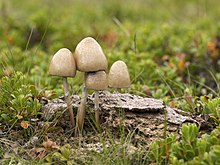Panaeolus semiovatus var. semiovatus, also known as Panaeolus semiovatus and Anellaria separata, and commonly known as the shiny mottlegill, ringed panaeolus, common fungus of the feces variety,[1] or egghead mottlegill, is a medium-sized buff-colored mushroom that grows on horse dung, and has black spores. Though nonpoisonous,[2] it is generally regarded as inedible and possessing a rather abysmal taste,[3] and a few people experience gastric upset after consumption.
| Panaeolus semiovatus var. semiovatus | |
|---|---|

| |
| Scientific classification | |
| Kingdom: | |
| Division: | |
| Class: | |
| Order: | |
| Family: | |
| Genus: | |
| Species: | |
| Variety: | P. semiovatus var. semiovatus
|
| Trinomial name | |
| Panaeolus semiovatus var. semiovatus Fr. (Lundell)
| |
| Synonyms | |
| |
| Panaeolus semiovatus var. semiovatus | |
|---|---|
| Gills on hymenium | |
| Cap is convex | |
| Hymenium is adnexed | |
| Stipe has a ring | |
| Spore print is black | |
| Ecology is saprotrophic | |
| Edibility is inedible | |
Description
editThe cap is up to 8 cm across, dark buff to white, parabolic to nearly convex in maturity. It is sticky when wet, and often wrinkles when dry. The stem is 15 cm by 20 mm, solid and smooth, with an annulus (ring) that is white, but is often found blackened by falling spores. The gills are adnexed, being wider in the middle, and narrowing at both ends, they are brown to black. The flesh is white, or straw-colored.[4][5]
This is a buff, or whitish-colored mushroom that grows in horse dung. It is widely distributed and is present in many temperate zones of the world.
The very similar Panaeolus semiovatus var. phalaenarum (Fr.) Ew. Gerhardt. 1996 syn. Panaeolus phalaenarum (Bull.) Quel. is more slender (cap 2–4 cm), and lacks the ring.[6]
- As seen below, this mushroom varies from white to dark buff in coloration.
-
Wild Panaeolus semiovatus var. semiovatus
-
Panaeolus semiovatus var. semiovatus on horse manure.
-
Close up of cap and gills. Note the black spores.
See also
editReferences
edit- ^ Arora, David (1986). Mushrooms demystified: a comprehensive guide to the fleshy fungi (Second ed.). Berkeley: Ten Speed Press. ISBN 978-0-89815-169-5.
- ^ Miller Jr., Orson K.; Miller, Hope H. (2006). North American Mushrooms: A Field Guide to Edible and Inedible Fungi. Guilford, CN: FalconGuide. p. 234. ISBN 978-0-7627-3109-1.
- ^ Phillips, Roger (2010). Mushrooms and Other Fungi of North America. Buffalo, NY: Firefly Books. p. 236. ISBN 978-1-55407-651-2.
- ^ Roger Phillips (2006). Mushrooms. Pan MacMillan. ISBN 0-330-44237-6.
- ^ Thomas Laessoe (1998). Mushrooms (flexi bound). Dorling Kindersley. ISBN 0-7513-1070-0.
- ^ Marcel Bon (1987). The Mushrooms and Toadstools of Britain and North Western Europe. Hodder and Stoughton. ISBN 0-340-39935-X.
Further reading
edit- Stamets, Paul (1996). Psilocybin Mushrooms of the World. Berkeley: Ten Speed Press. ISBN 0-9610798-0-0.